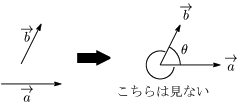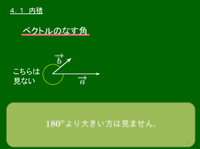高校数学[総目次]
数学B 第1章 ベクトル
| スライド | ノート | |
| 1. ベクトルと有向線分 | [無料] | |
| 2. ベクトルの演算 | [無料] | |
| 3. ベクトルの成分 | [無料] | |
| 4. ベクトルの内積 | [会員] | |
| 5. 位置ベクトル | [会員] | |
| 6. ベクトル方程式 | [会員] | |
| 7. 平面ベクトルの応用 | [会員] | |
| 8. 空間ベクトル | [会員] | |
| 9. 空間ベクトルの成分 | [会員] | |
| 10. 空間ベクトルの内積 | [会員] | |
| 11. 空間の位置ベクトル | [会員] | |
| 12. 空間ベクトルの応用 | [会員] | |
| 13. 空間のベクトル方程式 | [会員] |
4. ベクトルの内積
4.1 内積
ベクトルのなす角

2つのベクトル $\overrightarrow{\mathstrut a}$ と $\overrightarrow{\mathstrut b}$ について,2つの始点が一致するように平行移動させたときにできる角(図の$\theta$,ただし $0\leqq\theta\leqq\pi$)を,$\overrightarrow{\mathstrut a}$ と $\overrightarrow{\mathstrut b}$ のなす角という.
内積
$\overrightarrow{\mathstrut a}$ と $\overrightarrow{\mathstrut b}$ のなす角を $\theta$ とするとき, \[|\overrightarrow{\mathstrut a}||\overrightarrow{\mathstrut b}|\cos\theta\] を $\boldsymbol{\overrightarrow{\mathstrut a}}$ と $\boldsymbol{\overrightarrow{\mathstrut b}}$ の内積といい, \[\overrightarrow{\mathstrut a}\cdot\overrightarrow{\mathstrut b}\] で表す:
ベクトルの内積 $\overrightarrow{\mathstrut a}$ と $\overrightarrow{\mathstrut b}$ のなす角を $\theta$ とするとき, \[\overrightarrow{\mathstrut a}\cdot\overrightarrow{\mathstrut b}=|\overrightarrow{\mathstrut a}||\overrightarrow{\mathstrut b}|\cos\theta\]
$\overrightarrow{\mathstrut a}=\overrightarrow{\mathstrut 0}$ または $\overrightarrow{\mathstrut b}=\overrightarrow{\mathstrut 0}$ のときは,$\overrightarrow{\mathstrut a}\cdot\overrightarrow{\mathstrut b}=0$ と定める.
$\overrightarrow{\mathstrut a}\cdot\overrightarrow{\mathstrut a}=|\overrightarrow{\mathstrut a}||\overrightarrow{\mathstrut a}|\cos 0^\circ=|\overrightarrow{\mathstrut a}|^2$ であるから,
\[|\overrightarrow{\mathstrut a}|^2=\overrightarrow{\mathstrut a}\cdot\overrightarrow{\mathstrut a}\ \ \ \left(|\overrightarrow{\mathstrut a}|=\sqrt{\overrightarrow{\mathstrut a}\cdot\overrightarrow{\mathstrut a}}\ \right)\]
4.2 内積と成分

△OABにおいて,$\overrightarrow{\mathstrut\rm OA}=\overrightarrow{\mathstrut a}=(a_1,a_2)$,$\overrightarrow{\mathstrut\rm OB}=\overrightarrow{\mathstrut b}=(b_1,b_2)$ とし,$\overrightarrow{\mathstrut a}$ と $\overrightarrow{\mathstrut b}$ のなす角を $\theta$ とする.
余弦定理により,
\[{\rm AB}^2={\rm OA}^2+{\rm OB}^2-2{\rm OA}\cdot{\rm OB}\cos\theta\]
この式は,$\theta=0^\circ$ や $180^\circ$ のときも成り立つ.ベクトルで表せば,
\[|\overrightarrow{\mathstrut b}-\overrightarrow{\mathstrut a}|^2=|\overrightarrow{\mathstrut a}|^2+|\overrightarrow{\mathstrut b}|^2-2\overrightarrow{\mathstrut a}\cdot\overrightarrow{\mathstrut b}\]
\[\begin{align*}
\therefore \overrightarrow{\mathstrut a}\cdot\overrightarrow{\mathstrut b}&=\frac{|\overrightarrow{\mathstrut a}|^2+|\overrightarrow{\mathstrut b}|^2-|\overrightarrow{\mathstrut b}-\overrightarrow{\mathstrut a}|^2}2\\[5pt]
&=\frac{({a_1}^2\!+\!{a_2}^2)\!+\!({b_1}^2\!+\!{b_2}^2)\!-\!\{(b_1\!-\!a_1)^2\!+\!(b_2\!-\!a_2)^2\}}2\\[5pt]
&=\frac{2(a_1\,b_1+a_2\,b_2)}2\\[5pt]
&=a_1\,b_1+a_2\,b_2
\end{align*}\]
これは,$\overrightarrow{\mathstrut a}=\overrightarrow{\mathstrut 0}$,または $\overrightarrow{\mathstrut b}=\overrightarrow{\mathstrut 0}$ のとき,即ち $(a_1,a_2)=(0,0)$,または $(b_1,b_2)=(0,0)$ のときも成立.
内積と成分 $\overrightarrow{\mathstrut a}=(a_1,\ a_2)$,$\overrightarrow{\mathstrut b}=(b_1,\ b_2)$ のとき, \[\overrightarrow{\mathstrut a}\cdot\overrightarrow{\mathstrut b}=a_1\,b_1+a_2\,b_2\]
4.3 ベクトルのなす角
$\overrightarrow{\mathstrut 0}$ でない2つのベクトル $\overrightarrow{\mathstrut a}=(a_1,a_2)$,$\overrightarrow{\mathstrut b}=(b_1,b_2)$ のなす角を $\theta$ とすると, \[\overrightarrow{\mathstrut a}\cdot \overrightarrow{\mathstrut b}=|\overrightarrow{\mathstrut a}||\overrightarrow{\mathstrut b}|\cos\theta\] \[\begin{align*} \therefore\ \cos\theta&=\frac{\overrightarrow{\mathstrut a}\cdot\overrightarrow{\mathstrut b}}{|\overrightarrow{\mathstrut a}||\overrightarrow{\mathstrut b}|}\\[5pt] &=\frac{a_1b_1+a_2b_2}{\sqrt{{a_1}^2+{a_2}^2}\sqrt{{b_1}^2+{b_2}^2}} \end{align*}\]
ベクトルのなす角と内積 $\overrightarrow{\mathstrut 0}$ でない2つのベクトル $\overrightarrow{\mathstrut a}=(a_1,a_2)$,$\overrightarrow{\mathstrut b}=(b_1,b_2)$ のなす角を $\theta$ とすると, \[\begin{align*} \therefore\ \cos\theta&=\frac{\overrightarrow{\mathstrut a}\cdot\overrightarrow{\mathstrut b}}{|\overrightarrow{\mathstrut a}||\overrightarrow{\mathstrut b}|}\\[5pt] &=\frac{a_1b_1+a_2b_2}{\sqrt{{a_1}^2+{a_2}^2}\sqrt{{b_1}^2+{b_2}^2}} \end{align*}\]
例題 $\overrightarrow{a}=(-1,\ -2),\ \overrightarrow{b}=(3,\ 1)$ のなす角 $\theta$ を求めよ.
こたえ
\[\begin{align*} \overrightarrow{\mathstrut a}\cdot\overrightarrow{\mathstrut b}&=-1\cdot3+(-2)\cdot1=-5\\[5pt] |\overrightarrow{\mathstrut a}|&=\sqrt{(-1)^2+(-2)^2}=\sqrt5\\[5pt] |\overrightarrow{\mathstrut b}|&=\sqrt{3^1+1^2}=\sqrt{10} \end{align*}\] よって, \[\cos\theta=\dfrac{-5}{\sqrt5\,\sqrt{10}}=-\dfrac1{\sqrt2}\] $0^\circ\leqq\theta\leqq180^\circ$ より,$\underline{\boldsymbol{\theta=135^\circ}}$
ベクトルの垂直
$\overrightarrow{\mathstrut{a}}$ と $\overrightarrow{\mathstrut{b}}$ のなす角が $90^\circ$ のとき,「$\overrightarrow{\mathstrut{a}}$ と $\overrightarrow{\mathstrut{b}}$ は垂直である」といい, \[\overrightarrow{\mathstrut{a}}\perp \overrightarrow{\mathstrut{b}}\] で表す.
$\overrightarrow{\mathstrut{a}}\perp \overrightarrow{\mathstrut{b}}$ のとき,$\cos90^\circ=0$ であるから, \[\overrightarrow{\mathstrut{a}}\cdot \overrightarrow{\mathstrut{b}}=|\overrightarrow{\mathstrut{a}}|\,|\overrightarrow{\mathstrut{b}}|\cos90^\circ=0\]
逆に$\overrightarrow{\mathstrut{a}}\cdot \overrightarrow{\mathstrut{b}}=0$ のとき,2つのベクトルのなす角を $\theta$ とすると,
\[|\overrightarrow{\mathstrut{a}}|\,|\overrightarrow{\mathstrut{b}}|\cos\theta=0\]
よって,$|\overrightarrow{\mathstrut{a}}|\neq0$,かつ $|\overrightarrow{\mathstrut{b}}|\neq0$ ならば,$\cos\theta=0$.
$0^\circ\leqq\theta\leqq180^\circ$ より,$\theta=90^\circ$.従って $\overrightarrow{\mathstrut{a}}\perp\overrightarrow{\mathstrut{b}}$.
以上により次が成り立つ:
ベクトルの垂直条件 $\overrightarrow{\mathstrut{a}}\neq\overrightarrow{0}$ かつ$\overrightarrow{\mathstrut{b}}\neq\overrightarrow{0}$ のとき, \[\overrightarrow{\mathstrut{a}}\perp\overrightarrow{\mathstrut{b}}\iff\overrightarrow{\mathstrut{a}}\cdot\overrightarrow{\mathstrut{b}}=0 \] $\overrightarrow{\mathstrut{a}}=(a_1,a_2)$,$\overrightarrow{\mathstrut{b}}=(b_1,b_2)$ と成分で表されているときは, \[\overrightarrow{a}\perp\overrightarrow{b}\iff a_1a_2+b_1b_2=0 \]
注意
「$\overrightarrow{\mathstrut{a}}\neq0$ かつ $\overrightarrow{\mathstrut{b}}\neq0$ 」の仮定がなければ,
\[\begin{align*} &\overrightarrow{\mathstrut{a}}\cdot\overrightarrow{\mathstrut{b}}=0\\[5pt] \iff&\overrightarrow{\mathstrut{a}}\perp\overrightarrow{\mathstrut{b}}\ \underline{\boldsymbol{{\rm or}\ \overrightarrow{\mathstrut{a}}=\overrightarrow{\mathstrut{0}}\ {\rm or}\ \overrightarrow{\mathstrut{b}}=\overrightarrow{\mathstrut{0}}\ \ }} \end{align*}\]
のように下線部の条件が追加される.
4.4 内積の性質
内積の性質\begin{align*} &[1]\ \ \overrightarrow{\mathstrut{a}}\cdot\overrightarrow{b}=\overrightarrow{b}\cdot\overrightarrow{\mathstrut{a}}\ \ (\mbox{交換法則})\\[5pt] &[2]\ \ \overrightarrow{a}\cdot\overrightarrow{a}=\left|\overrightarrow{a}\right|^2\\[5pt] &[3]\ \ \overrightarrow{\mathstrut{a}}\cdot(\overrightarrow{b}+\overrightarrow{\mathstrut{c}})=\overrightarrow{\mathstrut{a}}\cdot\overrightarrow{b}+\overrightarrow{\mathstrut{a}}\cdot\overrightarrow{\mathstrut{c}}\ \ (\mbox{分配法則})\\[5pt] &[4]\ \ (\overrightarrow{\mathstrut{a}}+\overrightarrow{b})\cdot\overrightarrow{\mathstrut{c}}=\overrightarrow{\mathstrut{a}}\cdot\overrightarrow{\mathstrut{c}}+\overrightarrow{b}\cdot\overrightarrow{\mathstrut{c}}\ \ (\mbox{分配法則})\\[5pt] &[5]\ \ (k\overrightarrow{\mathstrut{a}})\cdot\overrightarrow{b}=\overrightarrow{a}\cdot(k\overrightarrow{b})=k(\overrightarrow{\mathstrut{a}}\cdot\overrightarrow{b})\ \ (k\mbox{ は実数}) \end{align*}
証明
2つのベクトルのなす角を $\theta$ とする.
[1] \[\begin{align*} (\mbox{左辺}) &=|\overrightarrow{\mathstrut a}||\overrightarrow{\mathstrut b}|\cos\theta\\[5pt] &=|\overrightarrow{\mathstrut b}||\overrightarrow{\mathstrut a}|\cos\theta\\[5pt] &=(\mbox{右辺}) \end{align*}\]
[2] \[\begin{align*} (\mbox{左辺}) &=|\overrightarrow{\mathstrut a}||\overrightarrow{\mathstrut a}|\cos0^\circ\\[5pt] &=|\overrightarrow{\mathstrut a}||\overrightarrow{\mathstrut a}|\\[5pt] &=(\mbox{右辺}) \end{align*}\]
[3] $\overrightarrow{\mathstrut a}\!=\!(a_1,a_2)$,$\overrightarrow{\mathstrut b}\!=\!(b_1,b_2)$,$\overrightarrow{\mathstrut c}\!=\!(c_1,c_2)$ とすると, \[\begin{align*} (\mbox{左辺}) &=(a_1,a_2)\cdot(b_1+c_1,b_2+c_2)\\[5pt] &=a_1(b_1+c_1)+a_2(b_2+c_2)\\[5pt] &=(a_1b_1+a_2b_2)+(a_1c_1+a_2c_2)\\[5pt] &=(\mbox{右辺}) \end{align*}\]
[4]は,[3]と同様に示される.
([1]と[3]を用いて示してもよい.)
[5] $\overrightarrow{\mathstrut a}\!=\!(a_1,a_2)$,$\overrightarrow{\mathstrut b}\!=\!(b_1,b_2)$ とすると, \[\begin{align*} (\mbox{左辺})&=(ka_1,ka_2)\cdot(b_1,b_2)\\[5pt] &=ka_1b_1+ka_2b_2\\[5pt] &=\left\{ \begin{array}{l} a_1\!\times\! kb_1\!+\!a_2\!\times\! kb_2\!=\!(a_1,b_1)\cdot(kb_1,kb_2)\!=\!(\mbox{中辺})\\[5pt] k(a_1b_1+a_2b_2)=(\mbox{右辺}) \end{array}\right. \end{align*}\]
■
補足
[5]により,$k(\overrightarrow{\mathstrut a}\cdot\overrightarrow{\mathstrut b})$ は簡単に $k\overrightarrow{\mathstrut a}\cdot\overrightarrow{\mathstrut b}$ と書く.
注意
$(\overrightarrow{\mathstrut a}\cdot\overrightarrow{\mathstrut b})\overrightarrow{\mathstrut c}=\overrightarrow{\mathstrut a}(\overrightarrow{\mathstrut b}\cdot\overrightarrow{\mathstrut c})$ のような式は成り立たない.
4.5 内積と正射影


2つのベクトル $\overrightarrow{\mathstrut\rm OA}$,$\overrightarrow{\mathstrut\rm OB}$ のなす角 $\theta$ が鋭角のとき,Bから直線OAに下ろした垂線の足を$\rm B’$とする.このとき $\overrightarrow{\mathstrut\rm OB’}$ を
$\overrightarrow{\mathstrut\rm OB}$ の $\overrightarrow{\mathstrut\rm OA}$(の上)への正射影ベクトル
という.
$\cos\theta=\dfrac{\rm OB’}{\rm OB}$ より, \[\begin{align*} \overrightarrow{\mathstrut\rm OA}\cdot\overrightarrow{\mathstrut\rm OB}&=|\overrightarrow{\mathstrut\rm OA}||\overrightarrow{\mathstrut\rm OB}|\cos\theta\\[5pt] &={\rm OA}\cdot{\rm OB}\cdot\frac{\rm OB’}{\rm OB}\\[5pt] &={\rm OA}\cdot{\rm OB’} \end{align*}\] このことから,内積の図形的な意味は次のようになる:
内積の図形的な意味 $\overrightarrow{\mathstrut 0}$ でない2つのベクトル $\overrightarrow{\mathstrut\rm OA}$,$\overrightarrow{\mathstrut\rm OB}$ のなす角が鋭角のとき,それらの内積は,$\overrightarrow{\mathstrut\rm OA}$ の大きさと,$\overrightarrow{\mathstrut\rm OB}$ の $\overrightarrow{\mathstrut\rm OA}$ への正射影ベクトルの大きさとの積である.
重要例題
$\overrightarrow{\mathstrut 0}$ でない2つのベクトル $\overrightarrow{\mathstrut a}$,$\overrightarrow{\mathstrut b}$ について,$\overrightarrow{\mathstrut b}$ の $\overrightarrow{\mathstrut a}$ への正射影ベクトル $\overrightarrow{\mathstrut c}$ を,$\overrightarrow{\mathstrut a}$,$\overrightarrow{\mathstrut b}$ を用いて表せ.
答

$\overrightarrow{\mathstrut c}=k\,\overrightarrow{\mathstrut a}$ ($k$ は実数)とおける.
$\overrightarrow{\mathstrut a}\perp(\overrightarrow{\mathstrut c}-\overrightarrow{\mathstrut b})$ より,$\overrightarrow{\mathstrut a}\cdot(\overrightarrow{\mathstrut c}-\overrightarrow{\mathstrut b})=0$.
$\therefore \overrightarrow{\mathstrut a}\cdot(k\,\overrightarrow{\mathstrut a}-\overrightarrow{\mathstrut b})=0$
$\therefore k=\dfrac{\overrightarrow{\mathstrut a}\cdot\overrightarrow{\mathstrut b}}{|\overrightarrow{\mathstrut a}|^2}$
故に,$\underline{\boldsymbol{\overrightarrow{\mathstrut c}=\dfrac{\overrightarrow{\mathstrut a}\cdot\overrightarrow{\mathstrut b}}{|\overrightarrow{\mathstrut a}|^2}\overrightarrow{\mathstrut a}}}$
正射影ベクトル $\overrightarrow{\mathstrut 0}$ でない2つのベクトル $\overrightarrow{\mathstrut a}$,$\overrightarrow{\mathstrut b}$ について,$\overrightarrow{\mathstrut b}$ の $\overrightarrow{\mathstrut a}$ への正射影ベクトルは, \[\frac{\overrightarrow{\mathstrut a}\cdot\overrightarrow{\mathstrut b}}{|\overrightarrow{\mathstrut a}|^2}\overrightarrow{\mathstrut a}\]
よくある質問
- 正射影される側のベクトル(例えば $\boldsymbol{\overrightarrow{\mathstrut a}}$ )の大きさや向きが変わると,正射影ベクトルはどうなりますか?
-
正射影される側のベクトル $\overrightarrow{\mathstrut a}$ の「大きさ」が変わっても正射影ベクトルは変化しない.また $\overrightarrow{\mathstrut a}$ に射影する場合も $-\overrightarrow{\mathstrut a}$ (「向き」が逆のベクトル)に射影する場合も正射影ベクトルは同じになる.
※ 以上の質問に対する詳しい解説はスライド (会員)で.
このページで疑問は解決されましたか?
こちらから数学に関するご質問・ご要望をお寄せください。
高校数学[総目次]
数学B 第1章 ベクトル
| スライド | ノート | |
| 1. ベクトルと有向線分 | [無料] | |
| 2. ベクトルの演算 | [無料] | |
| 3. ベクトルの成分 | [無料] | |
| 4. ベクトルの内積 | [会員] | |
| 5. 位置ベクトル | [会員] | |
| 6. ベクトル方程式 | [会員] | |
| 7. 平面ベクトルの応用 | [会員] | |
| 8. 空間ベクトル | [会員] | |
| 9. 空間ベクトルの成分 | [会員] | |
| 10. 空間ベクトルの内積 | [会員] | |
| 11. 空間の位置ベクトル | [会員] | |
| 12. 空間ベクトルの応用 | [会員] | |
| 13. 空間のベクトル方程式 | [会員] |

